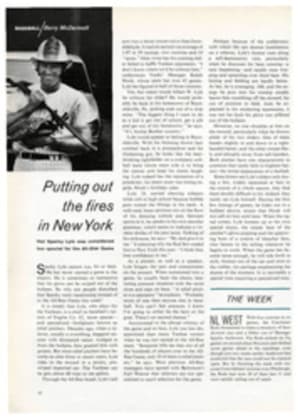
SCORECARD
THE CRYSTAL COMPUTER
After five months with a computer, Arnold J. Soolman, a systems analyst from Brookline, Mass. and a baseball fan as well, has come up with some unexpected conclusions.
For one, he has discovered that instead of being "75% of baseball," pitching and fielding combined never have been more than 54.9% of the game. Other tidbits:
The 1939 New York Yankees comprised the most talented team of all time (Joe DiMaggio, Charlie Keller, Tommy Henrich, Bill Dickey, Lou Gehrig, Joe Gordon, Frank Crosetti, Red Rolfe, Red Ruffing, Lefty Gomez, Spud Chandler, Johnny Murphy et al.).
The other greatest teams (in order): 1902 Pittsburgh Pirates, 1927 Yankees, 1936 Yankees, 1906 Chicago Cubs, 1937 Yankees, 1942 Yankees, 1929 Philadelphia Athletics, 1944 St. Louis Cardinals.
The worst teams in history were the 1915 Philadelphia A's and the 1932 Red Sox.
Don't argue with Soolman. To arrive at his sometimes startling conclusions he examined the records of every one of the 1,166 major league teams from 1901 through 1970 and took into account the special factors in the dead-ball era (1901-20), the prewar lively ball era (1921-45), the postwar preexpansion era (1946-60) and the modern expansion era (1961-70).
He then used plain and simple, if a bit old-fashioned, multivariate linear regression analysis.
KEEPING UP WITH BOBBY
Now that Bobby Fischer has settled down to play chess in his championship series with Boris Spassky (the American has won three and drawn one in the last four games), the matches have truly begun to catch on. Because of legal problems, television coverage has been restricted to a makeshift network of educational TV outlets in the Northeast (New York City, Rochester and Boston), but prospects are good that the show will go national very soon.
WNET (Channel 13), which carries the games in the New York City area, reports a phenomenal response. The audience for the second game was twice as large as for the first, and has been growing. A station spokesman said preliminary Nielsen ratings indicated a daytime audience of about one million. "We are getting upward of 300 calls a day from homes, offices and bars," she said. "Some people call from their offices, where they don't even have a television set, just to get the last move. There must be a lot of people out there playing these games on their own boards."
The programs feature a play-by-play account relayed by AP wire and telephone from Iceland to New York to Albany, where WNET produces the shows. Chess Master Shelby Lyman and a team of studio experts do the commentary and analysis, with occasional assistance by phone from the masters at Manhattan's Marshall Chess Club.
There is a charmingly amateur quality to the telecasts, with a lot of cross-chatter and kibitzing between Lyman and his studio panel, periods of dead air whenever a game situation stumps the experts and an aura of electric expectancy whenever the simulated teletype chatters out the latest move from Reykjavik.
If chess can catch on as a spectator sport, maybe those let's-speed-up-base-ball advocates will shut up at last.
WHO NEEDS MONEY?
The barter system used to be an accepted way of paying one's bills in this country. Although it has gone out of fashion here, it survives in Mexico.
Municipal authorities in Tlaxcala have announced that they will accept fighting bulls as tax payments. The bulls will be used for municipal festivals.
In the U.S. the Internal Revenue Service will accept no bull on income tax returns.
SIREN SONG
Those wily Texas Parks and Wildlife biologists who have been using horseflies as hypodermic needles (SI, July 24) now are fooling fish as well as bighorn sheep. By using recordings of ultrasonic mating calls, they hope to cull trash species such as carp from crowded waters. Experiments demonstrated that fish swim toward the mating calls. When several species were placed in the same large tank and specific calls were played simultaneously from different points around the tank, the species polarized, each responding to its own love call. The biologists expect to use the technique in the wild, removing the trash fish as they pantingly assemble around an underwater loudspeaker.
NO "YELLOW" FOR UNSER
He has come closer than any other driver to clocking 200 mph on an oval auto racing track, and so Bobby Unser reacted as one might suspect when the U.S. Auto Racing Club announced plans to slow down its championship race cars.
"These rules," he said, "are made by cigar-smoking, martini-sipping officials who sit behind desks but have never driven a race car.
"Cars are safer than ever now, and Indy-type racing is safer than any kind in the world. We're having less accidents than ever, but all these guys can think about is slowing down."
Bobby, who has shattered several world records with his Olsonite Eagle, topped that by setting an alltime one-lap mark of 196.678 mph this year.
The proposed changes call for reducing allowable engine size on overhead cam turbo-charged engines from 161 cu. in. to 140. This would cripple power plants that now dominate competition.
Another proposal would limit the amount of fuel used in all USAC races, rather than just Indy, Pocono and Ontario, Calif.
A proposal to reduce the total area of stabilizer wings brought this retort from Unser: "The worst thing they can do is cut back on the wings. This has stabilized the cars in the corners and made them safer. And the smaller the engine, the harder it will have to work, so the more engine fatalities there will be.
"It'll cost Dan Gurney [the owner of Unser's car] between half a million and $1 million if these rule changes go through."
The USAC rules committee will vote on the proposals next month. If approved, they will go before the USAC board in September for a final O.K.
Meanwhile, Unser is organizing to fight.
THE VERY EXPENSIVE WORM
Sea worms—chiefly the bloodworm and the sandworm—brought Maine diggers $2,056,000 last year. Saltwater anglers from Long Island south along the Atlantic Coast have been paying as much as $20 a pound at retail for the bloodworm. That is 10 times as much as they pay for live lobster in Maine.
But, though their numbers remain constant at 35 million harvested annually, the sea worms are getting smaller. Twenty years ago 44 commercial-size bloodworms made a pound and the slightly larger sandworms ran 40 to a pound. Now it takes about 175 bloodworms to make a pound.
Overdigging may account for the change. In 1948, when diggers first were licensed in Maine, 448 licenses were issued. In 1971 there were 1,396.
Blame it to some extent on unemployment in other areas, says Robert L. Dow, director of marine research for the Maine Department of Sea and Shore Fisheries. All a digger needs is a digging fork, a bucket and a pair of boots. He can earn $40 or more for four hours of labor on a tide.
But Dow also thinks the decline in worm size may be tied to "the temperature-climate cycle." Edwin P. Creaser Jr., a researcher at Boothbay Harbor, has found that where waters are warmer, worms tend to be smaller.
"We don't know exactly how long worms live," Creaser explains. "Certainly not more than five years at the very maximum, and probably at least a year less in warmer waters. The reason is that the worm matures faster and never reaches a very large size. The moment you start harvesting a smaller size product, you're overharvesting."
So the shrinkage of the marine worm could be due to both too many diggers and warmer waters.
But though the worms are getting smaller, their value keeps going up. That $2,056,000 last year was almost as much as the $2.7 million which Maine clams brought their diggers. And it is more than the combined value of all the herring, the sea scallops and the crabs landed in the state.
VINTAGE COWARDS
A plucky crew of transplanted Englishmen, augmented by local Tories, has for some years now been bumping heads after business hours in an amateur rugby league that flourishes in the New York area. In fact, they have been bumping heads for so many years that a lot of players are getting a bit long in the tooth to be playing against upstart youngsters who, in their insidious way, have gradually been taking over the league.
Retire? Never!
The vintage ruggers have announced formation of a brand-new senior team for men over 40. It will play on Sundays only—and only against teams willing to show respect for seniority. In the heat of a scrimmage the over-40s will be identifiable in their distinctive uniforms: gray with a yellow streak up the back.
DOOR-TO-DOOR BASKETBALL
It is the middle of the baseball season, football is just warming up and basketball seems far off—but there, fast-breaking down the highways of Louisiana, are Dale Brown, the new Louisiana State basketball coach, and his assistant, Jack Schalow.
Their car carries a trunkful of basketball nets, and as they move along they look for backyard baskets on which to hang them. Brown bought 1,000 nets from a Baton Rouge department store at cost—85¢ apiece. Now, every time he sees a goal in a backyard, he stops his car, knocks on the door and says, "Hello, I'm Dale Brown, the LSU basketball coach and I've got a net for your goal."
"A lot of people were suspicious," he says. "Thought I was selling something. Well I was. Basketball.
"The whole idea is to stimulate interest in LSU basketball. We give the net, a short poem on basketball written by one of my assistants, and a calling card."
Brown is looking into the possibility of having his nets dyed purple. LSU colors are purple and gold. He is also trying to figure out a way to get safely past goal-tending dogs.
OVER THE COUNTER IN THE PROS
It may have been the biggest trade in the history of professional football.
The Lake County (Ill.) Rifles of the Central States League gave up 21 players in exchange for one quarterback from the Delavan (Wis.) Red Devils. The Rifles got Bob Berezowitz, who threw 27 touchdown passes last season and 23 the year before. He is a fifth-grade teacher in the Woodstock (Ill.) school system and, because of his aerial skill, has become known as the Red Baron.
"Bob is experienced and smart," explained Jesse Vail, who is recreation director at the Joliet (Ill.) state prison when he is not moonlighting as coach of the Rifles. "He picks up the red dogs. He dumps off the ball to his running backs. He sees the secondary receivers. He thinks on his feet."
And besides, the Rifles had 200 would-be players attend their tryout camp, and thus had a surplus of bodies. Then, too, Delavan did not want to pay Berezowitz more than $40 per game. The Rifles will, though they are not saying how much more.
ILLUSTRATION
THEY SAID IT
•Bill Yeoman, University of Houston football coach, after opening ceremonies at a Pittsburgh Coach of the Year clinic, which was addressed by a conglomerate of sport celebrities, a priest and the mayor: "I thought they had the priest for the coaches, but after listening to the mayor, you knew everybody needed help."
•Gary Player, on Lee Trevino's physique: "If he didn't have an Adam's apple he'd have no shape at all."

